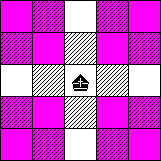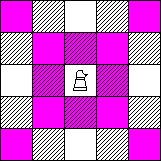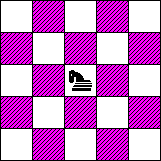Thronschach
A Chess Variation on a 42 Square Board
By
Glenn E. Overby II
Board and Pieces
Board: 5 files by 8 ranks, plus two squares at c0 and c9 (the thrones) for 42 squares.
Pieces: Each player has 10 pieces: Cardinal, Dragon, Immobilizer,
King, Marquis, and five Pawns.

- White: Pawns at a2, b2, c2, d2, e2; Cardinal at a1; Dragon at b1; Marquis at c1; King at d1; Immobilizer at e1.
- Black: Pawns at a7, b7, c7, d7, e7; Immobilizer at a8; King at b8; Marquis at c8; Dragon at d8; Cardinal at e8.
The King and Pawns move and capture as in Orthodox Chess. However, there is no castling or en passant capture. A pawn on its eighth rank gains the movement power of a King as long as it is on the eighth rank.
The four new pieces move and capture as follows:
The Cardinal,
first popularized in Capablanca's 10x8 variant, has
the combined movement ability of a Bishop and a Knight, much like the
modern Queen combines Bishop and Rook.

The Dragon is
found in Shogi (Japanese Chess) as the
promoted form of the Bishop. (The Japanese ryuha is actually a
dragon-horse). It combines the Bishop's movement with the Wazir, an old Islamic piece
which moves one square horizontally or vertically.

The Marquis was first seen by me in a 1999 large variant, Scirocco, although
similar pieces are older. It combines the Knight's movement with the
Wazir.

The Immobilizer comes from Robert Abbott's classic 1960s variant Ultima. Unlike traditional chess pieces, the Immobilizer cannot capture. It moves like an orthodox Queen, and any adjacent enemy piece is frozen in place...even the King! (Frozen pieces may not, however, commit suicide like in Ultima.)
Winning
In addition to ordinary checkmate, a player can win the game by moving any piece onto the opponent's throne (White's is at c0; Black's is at c9) at any time, unless the opponent can immediately capture it. Except when capturing an opponent or moving the King out of check, players cannot move to their own throne.
Creating Thronschach
Thronschach is a fortunate accident. I was developing a new Icehouse game to be played on a chessboard, and stopped by chessvariants.com to research some different pieces used in chess variations. In the sidebar was a link to their 42 squares contest, and everything changed.
First, I made the game under development playable on a 42-square board.
Next, I started to work on a second game, since I could enter two. Mindful of the injunction to make the games very different from each other, I resolved that the only point of commonality would be the board. (Later I let up on this, but only slightly. They're still quite different.)
I wanted Thronschach to be readily playable by people with only an ordinary board and pieces. It's easy to imagine one extra square in the middle behind each first rank, and to cover up three files. The original version used two Bishops to the left of a King, and two Knights to the right, instead of the current back rank. This was very playable, but sometimes a touch congested, and was judged to be too conservative for a contest entry.
The current version incorporated some cool new pieces. The Cardinal was the first odd piece I tested, given my use of Bishops and Knights originally. The Dragon was eventually selected because it, like the Cardinal, is a bishop-mover which is not color-bound. The Marquis was then picked for its symmetry (B+N, B+W, N+W). The Immobilizer has long been my favorite Ultima piece.
I generally use a Bishop for the Cardinal (he got promoted), a Queen for the Dragon (which also moves in eight lines), a Knight for the Marquis (he got promoted, too), and a Rook for the Immobilizer (from Ultima practice).
The board is longer than it is wide. But the pieces are built heavily on bishop- and knight-moves, so they can't strike all the way across the board. (The Immobilizer can, but it cannot capture!). The three offensive pieces are nicely balanced against each other, with maximum moves of 16, 12, and 12 places. And these maxima are available in only a small part of the board.
The concept of a throne space goes back to several early forms of chess. Sometimes it was part of the square battlefield, and sometimes it was an appendage. It adds the idea of defending a place as well as a person; wars have been won or lost in both ways.
Thronschach seems to be a faster game than orthodox chess. The Immobilizer features in a lot of quick mates or decisive attacks. The throne space allows some interesting tactics, and particularly favors an attacker in the endgame. And there are only 10 pieces per side.
Thanks to Armando Hernandez Marroquin, designer of the Chess Alfonso-X TrueType font which provided several piece symbols, and to playtesters William Bartlomiej and John Padavan for beating the holes out.
Computer Play
An implementation of Thronschach has been written for Zillions of Games. You can download it here:
Copyright © 2002 by Glenn E. Overby II. All rights reserved. This is an entry in The Chess Variant Pages' contest to design a variant on a board of exactly 42 squares. It is used here by permission.
WWW page created: January 15, 2002.